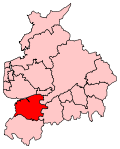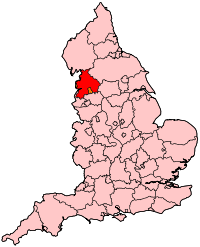South Ribble (UK Parliament constituency)
Coordinates: 53°43′01″N 2°41′49″W / 53.717°N 2.697°W
| South Ribble | |
|---|---|
|
County constituency for the House of Commons | |
 Boundary of South Ribble in Lancashire. | |
 Location of Lancashire within England. | |
| County | Lancashire |
| Electorate | 75,116 (December 2010)[1] |
| Major settlements | Leyland and Penwortham |
| Current constituency | |
| Created | 1983 |
| Member of parliament | Seema Kennedy (Conservative) |
| Number of members | One |
| Created from | Preston South, Fylde South and Chorley[2] |
| Overlaps | |
| European Parliament constituency | North West England |
South Ribble is a constituency[n 1] represented in the House of Commons of the UK Parliament since 2015 by Seema Kennedy, a Conservative.[n 2]
History
The seat of South Ribble was created for the 1983 general election, following the local government changes in the 1970s which saw the creation of the main constitutive borough of the same name.
Former Preston North MP Robert Atkins won the South Ribble constituency in 1983 and fought the seat in every election up to the 1997 general election. At that time, in dramatic bellwether fashion, Labour's David Borrow gained the seat on a clear majority, with nearly 26,000 votes, 2,000 less than Robert Atkins' victory in 1983 which was the equally an unusual landslide result. From the 1997 "landslide year" until 2010, David Borrow's vote total and majority consistently shrunk with a swing back to the Conservatives at every election. In terms of the other parties, Liberal Democrats have not thus far achieved better than third and 2005 saw UKIP nominating a candidate for the first time, and taking just over 1,200 votes. Borrow finally lost South Ribble in 2010 on a large two-party swing to Conservative Lorraine Fullbrook.
Boundaries
1983-1997: The Borough of South Ribble.
1997-2010: The Borough of South Ribble wards of Charnock, Farington, Howick, Hutton and New Longton, Kingsfold, Leyland Central, Leyland St Ambrose, Leyland St John's, Leyland St Mary's, Little Hoole and Much Hoole, Longton Central and West, Lostock Hall, Manor, Middleforth Green, Moss Side, Priory, and Seven Stars, and the District of West Lancashire wards of Hesketh with Becconsall, North Meols, Rufford, and Tarleton.
2010–present: The Borough of South Ribble wards of Broad Oak, Charnock, Earnshaw Bridge, Golden Hill, Howick and Priory, Kingsfold, Leyland Central, Leyland St Ambrose, Leyland St Mary's, Little Hoole and Much Hoole, Longton and Hutton West, Lowerhouse, Middleforth, Moss Side, New Longton and Hutton East, Seven Stars, and Whitefield, the District of West Lancashire wards of Hesketh with Becconsall, North Meols, Rufford, and Tarleton, and the Borough of Chorley wards of Eccleston and Mawdesley, and Lostock.
The seat's original boundaries were co-terminous with the South Ribble borough.[3] Due to its population figures, the borough of South Ribble and its parliamentary constituency haven't shared the same boundaries since although the towns of Leyland and Penwortham have always featured at the centre of the constituency.
For the 1997 general election the eastern villages of Bamber Bridge and Walton-le-Dale were moved to the Preston constituency. Following the review of parliamentary representation in Lancashire prior to the 2010 general election, Walton-le-Dale and Bamber Bridge were subsequently transferred into the Ribble Valley seat, along with the villages of Samlesbury, Higher Walton, Coupe Green, Gregson Lane, Lostock Hall, Farington and Farington Moss. This means the borough of South Ribble is now split between the South Ribble and Ribble Valley parliamentary seats.
Members of Parliament
| Election | Member[4] | Party | |
|---|---|---|---|
| 1983 | Robert Atkins | Conservative | |
| 1997 | David Borrow | Labour | |
| 2010 | Lorraine Fullbrook | Conservative | |
| 2015 | Seema Kennedy | Conservative | |
Elections
Elections in the 2010s
| Party | Candidate | Votes | % | ± | |
|---|---|---|---|---|---|
| Conservative | Seema Kennedy | 28,980 | 52.8 | +6.4 | |
| Labour | Julie Gibson | 21,559 | 39.3 | +4.2 | |
| Liberal Democrat | John Wright | 2,073 | 3.7 | -0.7 | |
| UKIP | Mark Smith | 1,387 | 2.5 | -11.6 | |
| Green | Andrew Wight | 494 | 0.9 | N/A | |
| National Health Action | Mark Jamell | 341 | 0.6 | N/A | |
| Majority | 7,421 | 13.5 | +2.2 | ||
| Turnout | 54,834 | 72 | +3.5 | ||
| Conservative hold | Swing | +1.1 | |||
| Party | Candidate | Votes | % | ± | |
|---|---|---|---|---|---|
| Conservative | Seema Kennedy | 24,313 | 46.4 | +0.9 | |
| Labour | Veronica Bennett | 18,368 | 35.1 | +0.4 | |
| UKIP | David Gallagher | 7,377 | 14.1 | +10.4 | |
| Liberal Democrat | Sue McGuire | 2,312 | 4.4 | -9.7 | |
| Majority | 5,945 | 11.3 | +0.6 | ||
| Turnout | 52,370 | 68.5 | +0.6 | ||
| Conservative hold | Swing | ||||
| Party | Candidate | Votes | % | ± | |
|---|---|---|---|---|---|
| Conservative | Lorraine Fullbrook | 23,396 | 45.5 | +7.1 | |
| Labour | David Borrow | 17,842 | 34.7 | -9.6 | |
| Liberal Democrat | Peter Fisher | 7,271 | 14.1 | -0.6 | |
| UKIP | David Duxbury | 1,895 | 3.7 | +1.5 | |
| BNP | Rosalind Gauci | 1,054 | 2.0 | +2.0 | |
| Majority | 5,554 | 10.8 | +6.2 | ||
| Turnout | 51,458 | 67.9 | +4.4 | ||
| Conservative gain from Labour | Swing | +8.1 | |||
Elections in the 2000s
| Party | Candidate | Votes | % | ± | |
|---|---|---|---|---|---|
| Labour | David Borrow | 20,428 | 43.0 | -3.4 | |
| Conservative | Lorraine Fullbrook | 18,244 | 38.4 | +0.3 | |
| Liberal Democrat | Mark Alcock | 7,634 | 16.1 | +0.6 | |
| UKIP | Kenneth Jones | 1,205 | 2.5 | N/A | |
| Majority | 2,184 | 4.6 | -3.7 | ||
| Turnout | 47,511 | 63.0 | +0.5 | ||
| Labour hold | Swing | -1.9 | |||
| Party | Candidate | Votes | % | ± | |
|---|---|---|---|---|---|
| Labour | David Borrow | 21,386 | 46.4 | −0.4 | |
| Conservative | Adrian Owens | 17,584 | 38.1 | +0.5 | |
| Liberal Democrat | Mark Alcock | 7,150 | 15.5 | +4.9 | |
| Majority | 3,802 | 8.3 | −0.9 | ||
| Turnout | 46,120 | 62.5 | −14.6 | ||
| Labour hold | Swing | −0.5 | |||
Elections in the 1990s
| Party | Candidate | Votes | % | ± | |
|---|---|---|---|---|---|
| Labour | David Borrow | 25,856 | 46.8 | +12.0 | |
| Conservative | Robert Atkins | 20,772 | 37.6 | −12.3 | |
| Liberal Democrat | Tim Farron | 5,879 | 10.6 | −4.2 | |
| Referendum | Mark Adams | 1,475 | 2.7 | N/A | |
| Liberal | Nigel R. Ashton | 1,127 | 2.0 | N/A | |
| Natural Law | Bibette Leadbetter | 122 | 0.2 | −0.2 | |
| Majority | 5,084 | 9.2 | −5.8 | ||
| Turnout | 55,231 | 77.1 | |||
| Labour gain from Conservative | Swing | +12.1 | |||
| Party | Candidate | Votes | % | ± | |
|---|---|---|---|---|---|
| Conservative | Robert Atkins | 30,828 | 47.5 | +0.3 | |
| Labour | Geoffrey Smith | 24,855 | 38.3 | +5.2 | |
| Liberal Democrat | Simon Jones | 8,928 | 13.8 | −6.0 | |
| Natural Law | Decter Ronald | 269 | 0.4 | N/A | |
| Majority | 5,973 | 9.2 | −4.9 | ||
| Turnout | 64,880 | 83.0 | +3.2 | ||
| Conservative hold | Swing | −2.5 | |||
Elections in the 1980s
| Party | Candidate | Votes | % | ± | |
|---|---|---|---|---|---|
| Conservative | Robert Atkins | 28,133 | 47.2 | −1.6 | |
| Labour | David Roebuck | 19,703 | 33.1 | +6.6 | |
| Liberal | Joseph Holleran | 11,746 | 19.7 | −5.0 | |
| Majority | 8,430 | 14.1 | |||
| Turnout | 59,582 | 82.5 | |||
| Conservative hold | Swing | −4.1 | |||
| Party | Candidate | Votes | % | ± | |
|---|---|---|---|---|---|
| Conservative | Robert Atkins | 27,625 | 48.8 | N/A | |
| Labour | Frank Duffy | 14,966 | 26.5 | N/A | |
| Liberal | Robert Walker | 13,960 | 24.7 | N/A | |
| Majority | 12,659 | 22.3 | N/A | ||
| Turnout | 56,551 | 78.0 | N/A | ||
| Conservative win (new seat) | |||||
See also
Notes and references
Notes
- ↑ A county constituency (for the purposes of election expenses and type of returning officer)
- ↑ As with all constituencies, the constituency elects one Member of Parliament (MP) by the first past the post system of election at least every five years.
References
- ↑ "Electorate Figures - Boundary Commission for England". 2011 Electorate Figures. Boundary Commission for England. 4 March 2011. Archived from the original on 6 November 2010. Retrieved 13 March 2011.
- ↑ "'South Ribble', June 1983 up to May 1997". ElectionWeb Project. Cognitive Computing Limited. Retrieved 14 March 2016.
- ↑ Crewe, Ivor (1983). British Parliamentary Constituencies - a statistical compendium. faber and faber.
- ↑ Leigh Rayment's Historical List of MPs – Constituencies beginning with "S" (part 4)
- ↑ Seema Kennedy MP [@SeemaKennedy] (21 April 2017). "Absolutely delighted to have been re-adopted as @Conservatives candidate for #SouthRibble for #GE2017 Thank you for…" (Tweet) – via Twitter.
- ↑ "Election Data 2015". Electoral Calculus. Archived from the original on 17 October 2015. Retrieved 17 October 2015.
- ↑ "South Ribble". BBC News. Retrieved 8 May 2015.
- ↑ "Election Data 2010". Electoral Calculus. Archived from the original on 26 July 2013. Retrieved 17 October 2015.
- ↑ "Election Data 2005". Electoral Calculus. Archived from the original on 15 October 2011. Retrieved 18 October 2015.
- ↑ "Election Data 2001". Electoral Calculus. Archived from the original on 15 October 2011. Retrieved 18 October 2015.
- ↑ "Election Data 1997". Electoral Calculus. Archived from the original on 15 October 2011. Retrieved 18 October 2015.
- ↑ "Politics Resources". Election 1997. Politics Resources. 1 May 1997. Retrieved 7 Jan 2011.
- ↑ C. Rallings & M. Thrasher, The Media Guide to the New Parliamentary Constituencies, p.138 (Plymouth: LGC Elections Centre, 1995)
- ↑ The 1997 election result is calculated relative to the notional, not the actual, 1992 result.
- ↑ "Election Data 1992". Electoral Calculus. Archived from the original on 15 October 2011. Retrieved 18 October 2015.
- ↑ "Politics Resources". Election 1992. Politics Resources. 9 April 1992. Retrieved 6 Dec 2010.
- ↑ "Election Data 1987". Electoral Calculus. Archived from the original on 15 October 2011. Retrieved 18 October 2015.
- ↑ "Election Data 1983". Electoral Calculus. Archived from the original on 15 October 2011. Retrieved 18 October 2015.